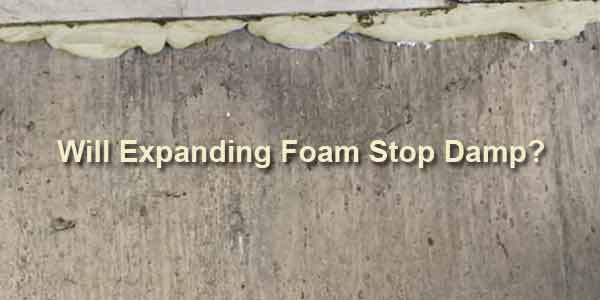The DIY Fix is reader supported. When you buy after clicking a link on our site, we may earn an affiliate commission.
Damp entering your property through small holes and cracks can be frustrating. It can also end up being expensive to fix, if left untreated. small defects and damage are common causes of water entering a property and are commonly referred to as penetrating damp.

When it comes to small gaps and holes that are allowing moisture into a property, there are several possible solutions that can help. One of these is expanding foam.
Many people use expanding foam to fill small holes, gaps, and cracks in their property. They may also consider using expanding foam as a solution for minor structural defects. But how successful will this be for stopping penetrating damp?
Expanding foam can be used to offer some protection from damp. However, in many situations it won’t be the best solution. It will offer some water-resistant qualities, but it is not completely waterproof. It will fill small gaps perfectly. But ideally, it should be used in conjunction with other waterproof building materials, to provide a watertight solution.
Click here to see popular expanding foams and read reviews on Amazon
What is Expanding Foam?
As the name suggests, expanding foam expands, and hardens once sprayed. It is a very quick and easy solution to fill small holes.
When the foam fully expands and dries, it can be trimmed down. Following this you could cover with filler, plaster, or just paint. It is ideal for sealing gaps around pipes and wires. As it seals and fills an area, it will give some protection against penetrating damp. This is because the foam seals up the hole. Which means that water and damp will find it harder to get inside.
With that said, expanding foam is generally considered water resistant, but it is not 100% waterproof. Therefore, where possible, you should try to add additional protection to exterior surfaces. For example:
- Mortar
- Render
- Masonry paint
How to Use Expanding Foam – Application
The first step of a successful application of expanding foam, is to clean the area you are treating. Use a dry, large paint brush to clear away any dust, dirt, or loose particles, in and around the area. If the area has plaster or render that needs removing, it is best to use a bolster chisel. You can also use a hammer on the area in question to loosen the surface
Once the area is clean, spray with water. This is necessary, as expanding foam needs moisture to cure. Dampening the area will enable the foam to cure.
It is important to carefully read the manufacturer’s instructions. All brands of expanding foam are similar. But there will always be slight variations that need to be adhered to.
Expanding foam is a skin irritant. So it is vital that you wear protective gloves during application.
Applying the foam is straightforward and simple. A spray gun or nozzle will be supplied with the product. This is attached to the can, as per the instructions. Shake the can vigorously. For best results the expanding foam should be applied with the can held upside down. The nozzle should be inserted into the area to be treated and apply gradually and carefully. Be mindful that the foam will expand to as much as twice its original size.
How to Use Expanding Foam – Post-Application
After the foam has been applied, mist the treated area with water. Again, this will enable the expanding foam to cure. If you decide that you need to apply another layer, spray water between each application. This will allow the foam to adhere. Next, leave it to dry. The exact length of time will be dependent on the manufacturer’s instructions. This is usually at least an hour. If possible, leave it for as much as twelve hours to ensure that the foam is totally set.
Remove any excess with a saw, Stanley knife or other similar tool.
Finally, use sandpaper to sand the area down and give it a smooth finish. It is then possible to fill, plaster, or paint over the affected area, as necessary.
Is it Worth Investing in an Applicator Gun?
There are a variety of expanding foams on the market. They are all quite similar and will do pretty much the same job. Most come with a disposable plastic applicator. This is screwed onto the nozzle. These are perfectly adequate. But plastic applicators do have some disadvantages.
The foam will often set inside the applicator, and this can be difficult to remove. Even in a single-use application, this can be troublesome. It is not uncommon for the applicator to become bunged up during use. This can mean that a can of expanding foam becomes useless.
An alternative is to buy an applicator gun. These fit dedicated cans, but they are much easier to use again and again. As they are pressurized, so the nozzle of the gun does not become blocked and is easy to clean.
Conclusion – Can expanding foam stop damp?
Expanding foam is a versatile and reliable product that has many uses. It is ideal for use with small gaps and holes, or for dealing with small-scale structural defects. It can also provide some level of protection against penetrating damp.
In many cases, it can be a long-standing solution. However, you should remember, it is not completely waterproof. Therefore, it is best suited for smaller issues and will work best in combination with other waterproofing solutions.

